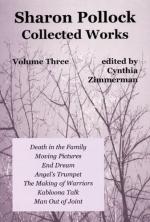|
This section contains 5,371 words (approx. 18 pages at 300 words per page) |

|
SOURCE: Kerr, Rosalind. “Borderline Crossings in Sharon Pollock's Out-Law Genres: Blood Relations and Doc.” Theatre Research in Canada 17, no. 2 (1996): 200-15.
In the following essay, Kerr analyzes Blood Relations and Doc to reveal the correlation between Pollock's use of non-traditional theater styles and techniques with her plays about women who break from their traditional roles in a patriarchal society.
Sharon Pollock's well-known plays, Blood Relations and Doc, can be read as “out-law genres” by extending the criteria which Caren Kaplan has outlined to designate women's renegade texts to theatrical representations. Both plays mix conventionally unmixable theatrical elements and use collaborative discursive practices to expose the myth that texts are individually authored, creating alternative texts based on a discourse of situation or a “politics of location.” After her split-subject representation of the notorious parent-killer, Lizzie Borden, Pollock crosses back into Canadian territory to create her own version of the excluded...
|
This section contains 5,371 words (approx. 18 pages at 300 words per page) |

|


